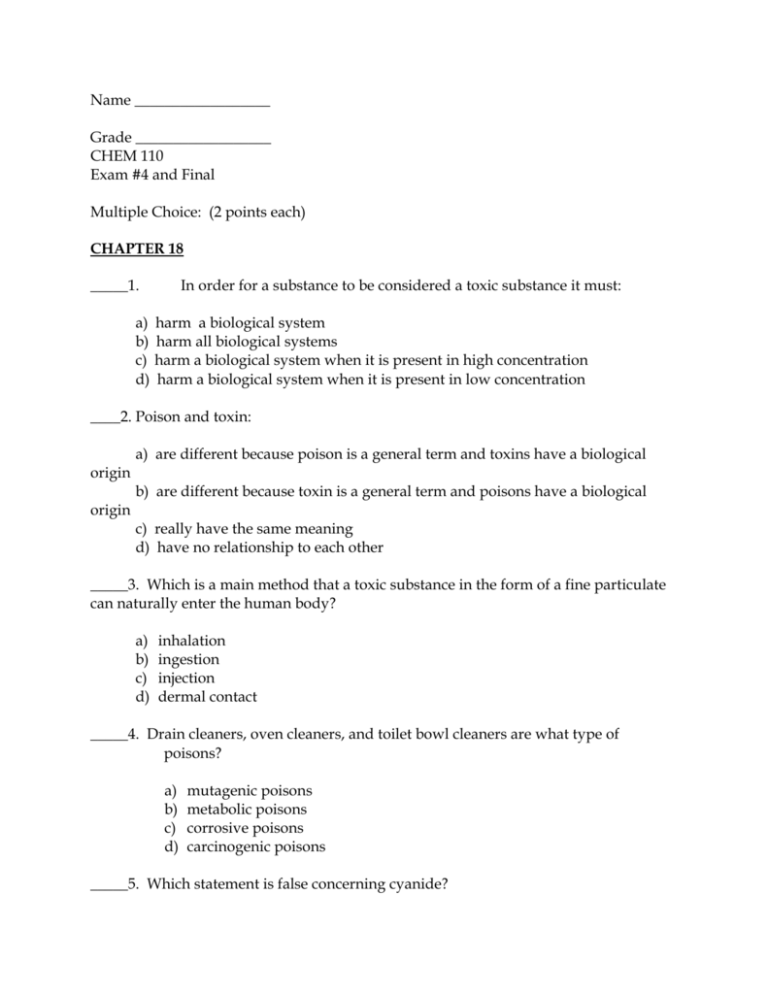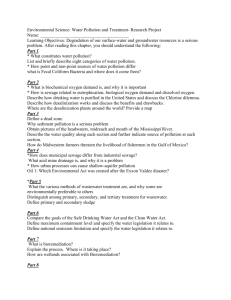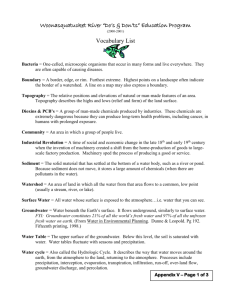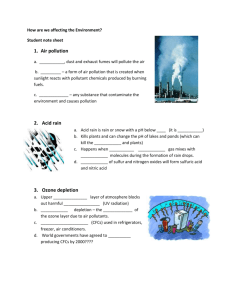Exam # 4 / Final Exam
advertisement

Name __________________ Grade __________________ CHEM 110 Exam #4 and Final Multiple Choice: (2 points each) CHAPTER 18 _____1. a) b) c) d) In order for a substance to be considered a toxic substance it must: harm a biological system harm all biological systems harm a biological system when it is present in high concentration harm a biological system when it is present in low concentration ____2. Poison and toxin: a) are different because poison is a general term and toxins have a biological origin b) are different because toxin is a general term and poisons have a biological origin c) really have the same meaning d) have no relationship to each other _____3. Which is a main method that a toxic substance in the form of a fine particulate can naturally enter the human body? a) b) c) d) inhalation ingestion injection dermal contact _____4. Drain cleaners, oven cleaners, and toilet bowl cleaners are what type of poisons? a) b) c) d) mutagenic poisons metabolic poisons corrosive poisons carcinogenic poisons _____5. Which statement is false concerning cyanide? a) b) c) d) cyanide is used commercially as a poison cyanide is used in electroplating cyanide may cause deaths in fires involving polyacrylonitrile carpets there is no antidote for cyanide poisoning _____6. Chelating agents are effective as antidotes for heavy metal poisoning because they: a) change the metal atom to an ion which makes it chemically inactive b) change the metal ion to a neutral atom which makes it chemically inactive c) surround and bind the metal and excrete in the urine to remove it from the body d) destroy the metal atom _____7. Lead poisoning has a greater impact on children than adults for all of the following reasons EXCEPT: a) b) c) d) children are more likely than adults to eat paint children can excrete more lead than adults children retain lead in their bloodstream longer than adults lead is absorbed slower in the bones of children than it is in the bones of adults _____8. Botulinum toxin is most likely to be found in: a) b) c) d) commercially canned foods home canned acidic vegetables home canned non-acidic vegetables fresh picked vegetables _____9. The organ in the human body that can detoxify some poisons is: a) b) c) d) the liver the gall bladder the kidneys the lungs _____10. In the past teratogens have been identified in specific forms in all of the following EXCEPT: a) sleeping pills b) chlorofluorocarbons in aerosol containers c) alcohol d) drug treatments for acne _____11. Which statement is FALSE as related to the concept of mutation. a) a protein may result with an incorrect sequence of amino acids. b) only chemicals cause mutations c) a mutation of DNA in a germ cell may result in a hereditary disease passed on to offspring d) a mutation in a somatic cell may cause no damage or may lead to cancer. _____12. Which is not a distinction between a benign and malignant tumor? a) cells in malignant tumors always divide faster than the cells in normal tissue b) malignant cells migrate through the body to other tissues and destroy them c) benign tumors grow more slowly than normal cells and do not spread to other tissue d) benign tumors may regress spontaneously CHAPTER 19 _____13. The largest percentage by mass of solid waste is: a) b) c) d) plastic paper food yard wastes _____14. An advantage in the incineration of garbage is: a) dramatic increase in the volume of solid waste b) heat produced may be used as an energy source c) older plants may have significant air pollution _____15. Which process does NOT occur to a significant extent in a modern land fill? a) b) c) d) leaks leading to groundwater contamination garbage is compacted major biodegradation by microorganisms methane is the result of anaerobic decomposition ____16. A hazardous waste substance has the following properties EXCEPT: a) b) c) d) increase a person's chances of dying pose a road hazard to motor vehicles pose a substantial present hazard or future hazard to human health pose a present or future hazard to the environment _____17. Reactive wastes include all of the following EXCEPT: a) b) c) d) wastes than can easily explode wastes than decompose because of a reaction with sunlight wastes than generate toxic gases when exposed to a weak acid or base wastes that have a violent reaction with water _____18. Which is NOT a method to convert hazardous wastes into less hazardous forms. a) deep well injection b) bioremediation using microorganisims to decompose wastes c) incineration and thermal treatment d) chemical methods to change the "form" of the waste. _____19. A hazardous dump site has to be cleaned up by the parties responsible for creating it. If the EPA cleans up the site the responsible parties can be sued for: a) the clean up costs b) three times the clean up costs c) twice the clean up costs d) four times the clean up costs _____20. Which is not true about the Love Canal? a) an elementary school was built on land bordering the canal b) nearly 1,000 homes were built close to the Love Canal c) there were no noticeable effects from the dumping site until several years of heavy precipitation caused the buried chemical residues to come to the surface d) studies done by EPA identified 82 chemicals emerging from the dump site, several of these chemicals turned out to be known or suspected carcinogens e) higher than average rates of miscarriages, children with birth defects, and some forms of cancer were found in the population 21. USE: "Assessing Risk of Hazardous Chemicals" text p. 552-53. a)(4) List the four main steps in risk analysis including a sentence or two explanation. b)(3) Chemical X, a suspected mutagen, is used in the Ames test and causes the salmonella culture to grow colonies. Explain specifically how and why this happens. 22. (8) Use NY Times Mar 6, 2001- “New Pollution Tool: ...” See article at the end of the exam List 4 types of chemicals along with 4 respective methods that use plants for removing them from contaminated sites. Give some specific details about how each of them work. Start of FINAL EXAM 23.(4) Explain the difference between "science" and "technology". Provide at least one clear example of "science" and "technology" and how each impacts on society. 24.(6) Homer E. Homespun has an Internet page which announces his revolutionary new "free energy device" which produces electric power without any fuel. What steps, processes, or questions would you investigate to determine the validity of this device before you make a decision of whether or not to invest in it. Is there anything in the statements that is “wrong” science? (Note: As a future consumer, this question is to be answered based upon general knowledge you have gained in the course. There is nothing to “look up” to answer the question. In reality, I did get an email of this nature this past summer.) 25.(35) The "Story of..." Select ONE of the products listed at the end of this question to write a "Story Of...". Think of this assignment as detailing the birth, life, and death of a consumer product. You will give details starting with the basic raw materials that it is made from, to making the product, to using the product, to disposing of the product. What are the environmental impacts at every stage listed above. More specific details of how to answer this are listed below. Use the text book as a first source of information, other sources of information include: a science encyclopedia, use search tools on the internet. Here are a few general links to help you search for information: How Products are Made - use the search tool and type in a product name. How Stuff Works Wikipedia Finally if you can not find specific information (in most cases, you probably will not), just carefully think about all the steps/environmental impacts that might occur. This question is designed for you to review a variety of types of pollution and energy uses in the process of obtaining the initial raw material and subsequent processing of the material to make a useful product. You had a preliminary chance to think about this type of question in Topic 12 with the Life Cycle analysis of paper vs. plastic. Most people did not go into very much depth for that question. Here I am asking for more depth as it is a review of what you have learned in the entire course. Your description of the product must contain ALL of the information in each part. (Each sub part numbered question is worth about 6 points. As you write, put in the numbers to indicate which part you are addressing and make it easy for me to follow.) Life Cycle Analysis of a Product: Life cycle analysis is a method to characterize the raw materials and energy used to make a product. In addition, for each step also analyze how much solid waste, water pollution, and air pollution is generated at each life cycle step of the product's life. 1. Introduction: Give a general description of the product (technology), its uses, and why modern society needs this particular product. Life Cycle Steps: 2. Extraction and Processing of a Raw material - raw materials (what chemical elements or compounds are part of the product? What are the basic resources where you would find the elements and compounds in the product?), energy sources, pollution (Be specific about the type and location of pollution and specific molecules involved) 3. Manufacturing and packaging - describe and/or give chemical equations of the synthesis or methods to convert from the raw material to the final product ( use specific names and/or formulas of the chemical compounds), energy sources, pollution 4. Transportation ( from raw material step to Mfg./Distribution of Product) - energy sources and pollution (Be specific about the type and location of pollution and specific molecules involved) 5. Useful life, maintenance of product, possible reuse 6. Possible Recycling - connects back to # 2 or 3 - energy sources and specific pollution and Final Disposal of Waste - specific pollution possible or prevented by proper treatment. To answer this question, try to be specific for each life cycle step. Specific means what source of energy, what specific types (molecules) of air or water pollution. You had a preliminary chance to think about this type of question in Topic 12 with the analysis of paper vs. plastic. Most people did not go into very much depth for that question. Here I am asking for more depth as it is a review of what you have learned in the entire course. Example: Story of PVC pipes. http://www.elmhurst.edu/~chm/onlcourse/chm110/quizzes/storyof.html CHOOSE ONE OF THE FOLLOWING: Beer p.446 Cement p. 302 and http://www.elmhurst.edu/~chm/onlcourse/chm110/outlines/limestone.html Battery dry cell p. 203-206 Battery lead-acid p. 207 Any plastic of your choice except PVC Chap 9 Rubber p. 277 Laundry Detergents p. 255, 516-520 Any other household product in Chap 17 "New Pollution Tool: Toxic Avengers With Leaves" NY Times Article Andrew C. Revkin; Copyright New York Times Company Mar 6, 2001 As scientists struggle to find cheaper, easier ways to clean up polluted soil and groundwater, they are increasingly wielding a novel tool: plants. In the United States alone, the cost of decontaminating tens of thousands of toxic sites on factory grounds, farms and military installations is expected to eventually surpass $700 billion, several analyses show. The main approach so far, digging out offending chemicals and carting them to special andfills, is costly and disruptive, often requiring fleets of trucks, forests of mechanical wells and other equipment. After a decade of field and greenhouse tests, a variety of techniques harnessing the absorptive power of plants' roots appear poised for a much expanded role. Hundreds of species of plants, together with the fungi and bacteria that infuse the rhizosphere, the ecosystem around roots, represent the botanical equivalent of detox centers, seeking and often breaking down molecules that can harm most other life, soil scientists and botanists say. There are sunflowers that capture uranium, ferns that thrive on arsenic, alpine herbs that hoard zinc, mustards that lap up lead, clovers that eat oil and poplar trees that destroy dry-cleaning solvents. In fact, poplars are so effective that people in the fast-growing ''phytoremediation'' business have a new name for them. ''A stand of poplars is a self-assembling solarpowered pump-and-treat system,'' said Steven A. Rock, an environmental engineer in the National Risk Management Research Laboratory of the federal Environmental Protection Agency in Cincinnati. Dr. Raskin conducted early tests of ways to exploit this mechanism to sop up radioactive substances and heavy metals. One of the most striking tests took place in 1995 in a small pond within sight of the Chernobyl nuclear power plants n Ukraine, where sunflowers were grown on Styrofoam rafts with their roots dangling in the water. The pond, like everything for miles around, was contaminated with Strontium 90, Cesium 137 and other harmful radioactive substances released during the reactor fire in 1986. Within days, the sunflowers, which have dense mops of roots, accumulated levels of cesium and strontium that were several thousand times as high as the concentrations in the water. Putting Trees to Work One of the most established techniques is using trees, mostly poplars and willows, to pump and treat groundwater from aquifers contaminated with solvents or other toxic organic compounds. Phytokinetics Inc., based in North Logan, Utah, is one of more than half a dozen companies deploying trees to treat such sites. At the peak of the growing season, said Dr. Ari M. Ferro, a biochemist and Phytokinetics' president, each tree can pump more than 15 gallons of water each day. At former oil refineries in Wyoming and Montana, the company has planted plots with 1,000 trees per acre, resulting in a pumping rate of 10 gallons a minute per acre. ''The trees are pumping like crazy,'' Dr. Ferro said. ''The contaminants get sucked up into the root zone and biodegraded.'' Other trees are being put to work, with plantings of koa on a pineapple plantation in Hawaii extracting ethylene dibromide from groundwater. The quickest growth in the business is in the use of plants to remove heavy metals from soil. One of the notable successes in this area came last year in Detroit, when Edenspace Systems, a phytoremediation company in Chantilly, Va., completed a cleanup of a leadlaced plot of land tucked amid a complex of DaimlerChrysler buildings. The top four feet of soil was bulldozed to a nearby area and planted in sunflowers and then Indian mustard, both of which are known to accumulate lead. The lead concentration in the soil was reduced 43 percent, bringing it below federal and state limits. The project cost $900,000, according to Michael Curry, the remediation project manager for the company. But that was more than $1 million less than it would have cost to cart the 5,700 cubic yards of soil to a hazardous waste landfill. Instead, only a few cubic yards of tainted plant material had to be disposed of, he said. A Plant That Loves Arsenic The latest discovery came at a central Florida lumberyard where the ground was badly contaminated with arsenic compounds from wood preservatives. Arsenic is so toxic to most plants that it is an ingredient in some herbicides. But after scientists at the University of Florida tested 14 plant species growing there, last year they found that the brake fern, common in the Southeast and other parts of the world, had arsenic in its fronds and stems at more than 200 times the concentration in the soil. The work was reported last month in Nature. Under a licensing deal, the fern is being sold by Edenspace to filter the element out of water. The E.P.A. recently reduced limits for arsenic in drinking water in this country, and it also contaminates thousands of wells in Bangladesh. Dr. Lena Q. Ma, an associate professor of soil and environmental chemistry at the university and the study leader, said her main interest was determining how the plant works. ''It not only tolerates arsenic, it loves it,'' Dr. Ma said. ''It has to have some mechanism to take it up and store it in a form that doesn't interfere with the plant and kill it. That's our next work.'' ''Plants as Pollution Sponges'' Using plants to clean areas of contaminated soil or groundwater shows promise as an alternative to the traditional system of digging out pollutants and trucking them to landfills. Treating Metal Contaminants: Some plants can accumulate very high levels of metal pollutants, removing them from soil and groundwater. PHYTOEXTRACTION Plant roots can absorb lead, arsenic, zinc and other metals and store them in the leaves. Plants can then be harvested and incinerated or recycled. RHIZOFILTRATION Plants can also be raised in greenhouses where water can pass by their dangling roots, which absorb certain pollutants. PHYTOSTABILIZATION Some plants, like the poplar tree, prevent contamination from migrating underground, essening the likelihood that the pollution will reach wells or percolate to the surface and taint streams. Treating Organic Contaminants: Organic pollutants are broken down by plants or by the micro-organisms that thrive around roots. PHYTODEGRADATION Poplars are also good at breaking down toxic organic chemicals into less harmful compounds, which they store or slowly release into the air. PHYTOVOLATILIZATION Some pollutants pass through plant leaves and evaporate into the atmosphere. There is some concern about how this may contaminate air. Radioactive Elements Sunflowers and other plants have been tested as a way to reduce levels of radioactive substances in water and soil. Sunflowers reduced high levels of strontium and cesium near the Chernobyl nuclear power plant. Kochia plants and willow trees have also been used to clean cesium in the Argonne National Laboratory-West in Idaho. Sewage Treatment Plants Constructed wetlands are used alone or as an addition to sewage treatment plants to clean and recycle wastewater. Polluted water passes through constructed wetlands containing reed plants, which attract micro-organisms that help purify the wastewater. (Sources: Environmental Protection Agency, American Society of Plant Physiologists, Edenspace.)(pg. F1)







